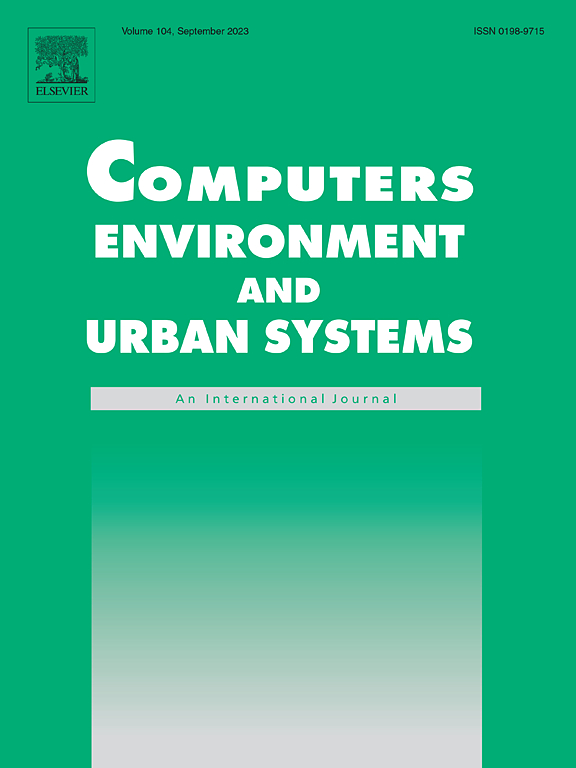Model-based estimation of the isolated impacts of urban expansion on projected streamflow values under varied climate scenarios
IF 8.3
1区 地球科学
Q1 ENVIRONMENTAL STUDIES
Computers Environment and Urban Systems
Pub Date : 2025-02-16
DOI:10.1016/j.compenvurbsys.2025.102259
引用次数: 0
Abstract
The use of computationally intensive hydrologic models under future climate scenarios has become a common practice to project water resource concerns in the coming decades. Under this approach, hydrologic models are parameterized and run under various climate forcings. Although urban areas are expected to expand during the time frame of these simulations, potentially impacting watershed hydrology, the uncertainty of forecasted streamflow is usually estimated based on the ensemble of climate scenarios, with minimal (if any) attention given to the uncertainty introduced by land transformations. The objective of this study is to quantify the Isolated Impacts on Projected Streamflow (IIPS) caused by urban expansion as climate changes in a watershed in the midwestern United States. IIPS time series were estimated as the difference between projected streamflows under future climate scenarios with and without urban expansion and weighted by the historical (1980–2010) monthly average. Two gradual and two abrupt urbanization scenarios, having equivalent developed areas by the end of the 21st century, were implemented. Results indicate that gradual urbanization could result in both increased (up to 26 %) and decreased (up to 16 %) projected streamflows, suggesting the increase in variability of extremes, with potential impacts on human and natural systems. Yearly minimum and maximum IIPS for all scenarios were found to be more likely to occur in summer and fall months, respectively. Impacts of the abrupt urban expansion were mainly observed in the cumulative IIPS and the ensemble variability of extreme IIPS. These results provide insights into the uncertainty of future streamflow estimates attributable to urban expansion.
不同气候情景下城市扩张对预估流量的孤立影响的基于模型的估算
在未来气候情景下使用计算密集型水文模型已成为预测未来几十年水资源问题的一种普遍做法。在这种方法下,水文模型被参数化并在各种气候强迫下运行。虽然预计城市地区在这些模拟的时间范围内会扩大,可能会影响流域水文,但预测流量的不确定性通常是根据气候情景的集合来估计的,很少(如果有的话)注意到土地改造带来的不确定性。本研究的目的是量化美国中西部流域气候变化引起的城市扩张对预计流量(IIPS)的孤立影响。IIPS时间序列估计为未来气候情景下有和没有城市扩张的预测流量之差,并加权历史(1980-2010)月平均值。到21世纪末,中国城市化将出现两种渐进式和两种突发性的情景,并形成相当的发达地区。结果表明,逐渐城市化可能导致预估流量增加(最多26%)和减少(最多16%),这表明极端事件的变异性增加,对人类和自然系统有潜在影响。所有情景的年最小和最大IIPS分别更有可能发生在夏季和秋季。城市突发性扩张的影响主要体现在累积IIPS和极端IIPS的集合变率上。这些结果提供了对归因于城市扩张的未来流量估计的不确定性的见解。
本文章由计算机程序翻译,如有差异,请以英文原文为准。
求助全文
约1分钟内获得全文
求助全文
来源期刊

Computers Environment and Urban Systems
Multiple-
CiteScore
13.30
自引率
7.40%
发文量
111
审稿时长
32 days
期刊介绍:
Computers, Environment and Urban Systemsis an interdisciplinary journal publishing cutting-edge and innovative computer-based research on environmental and urban systems, that privileges the geospatial perspective. The journal welcomes original high quality scholarship of a theoretical, applied or technological nature, and provides a stimulating presentation of perspectives, research developments, overviews of important new technologies and uses of major computational, information-based, and visualization innovations. Applied and theoretical contributions demonstrate the scope of computer-based analysis fostering a better understanding of environmental and urban systems, their spatial scope and their dynamics.
 求助内容:
求助内容: 应助结果提醒方式:
应助结果提醒方式:


